Theravāda is the most commonly accepted name of Buddhism's oldest existing school. The school's adherents, termed Theravādins, have preserved their version of Gautama Buddha's teaching or Buddha Dhamma in the Pāli Canon for over two millennia.
A tulku is a distinctive and significant aspect of Tibetan Buddhism, embodying the concept of enlightened beings taking corporeal forms to continue the lineage of specific teachings. The term "tulku" has its origins in the Tibetan word "sprul sku", which originally referred to an emperor or ruler taking human form on Earth, signifying a divine incarnation. Over time, this term evolved within Tibetan Buddhism to denote the corporeal existence of highly accomplished Buddhist masters whose purpose is to ensure the preservation and transmission of a particular lineage.
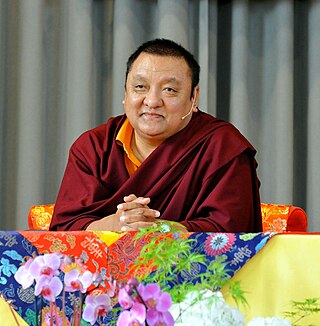
The Shamarpa, also known as Shamar Rinpoche, or more formally Künzig Shamar Rinpoche, is the second oldest lineage of tulkus. He is one of the highest lineage holders of the Karma Kagyu school of Tibetan Buddhism and is regarded as the mind manifestation of Amitābha. He is traditionally associated with Yangpachen Monastery near Lhasa.

Ajahn Khemadhammo OBE is a Theravāda Buddhist monk. He is one of the founders of the Thai Forest Tradition in the West.
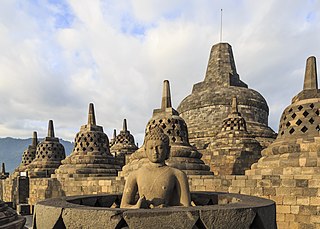
Buddhist religious architecture developed in the Indian subcontinent. Three types of structures are associated with the religious architecture of early Buddhism: monasteries (viharas), places to venerate relics (stupas), and shrines or prayer halls, which later came to be called temples in some places.
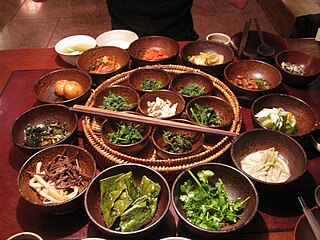
Buddhist vegetarianism is the practice of vegetarianism by significant portions of Mahayana Buddhist monks and nuns and some Buddhists of other sects. In Buddhism, the views on vegetarianism vary between different schools of thought. The Mahayana schools generally recommend a vegetarian diet because they claimed Gautama Buddha set forth in some of the sutras that his followers must not eat the flesh of any sentient being.
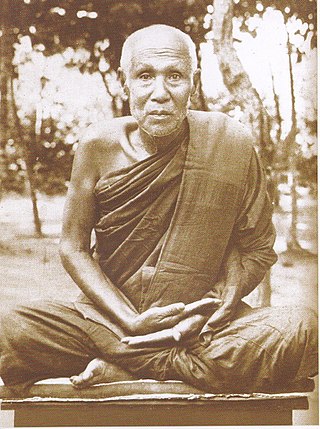
Ajahn Sao Kantasilo (1859–1942) was a monk in the Thai Forest Tradition of Theravada Buddhism. He was a member of the Dhammayuttika Nikaya.
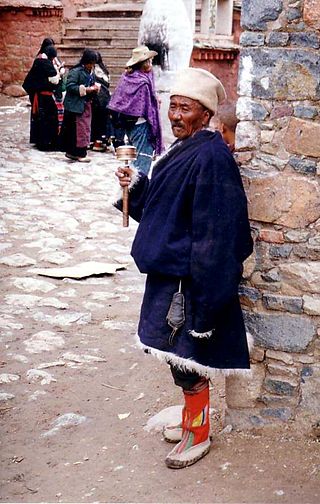
The most important places in Buddhism are located in the Indo-Gangetic Plain of southern Nepal and northern India. This is the area where Gautama Buddha was born, lived, and taught, and the main sites connected to his life are now important places of pilgrimage for both Buddhists and Hindus. Many countries that are or were predominantly Buddhist have shrines and places which can be visited as a pilgrimage.
Namgyal Rinpoche, Karma Tenzin Dorje (1931–2003), born Leslie George Dawson in Toronto, Canada, was a Tibetan Buddhist lama in the Karma Kagyu tradition.

Women in Buddhism is a topic that can be approached from varied perspectives including those of theology, history, anthropology, and feminism. Topical interests include the theological status of women, the treatment of women in Buddhist societies at home and in public, the history of women in Buddhism, and a comparison of the experiences of women across different forms of Buddhism. As in other religions, the experiences of Buddhist women have varied considerably.
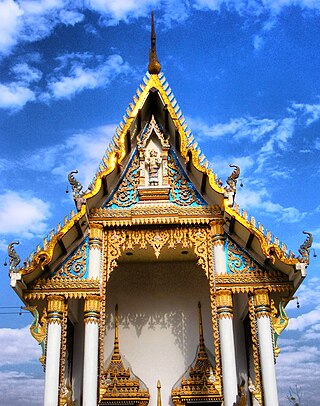

A wat is a type of Buddhist temple and Hindu temple in Cambodia, Laos, East Shan State, Yunnan, the Southern Province of Sri Lanka and Thailand. The word wat was borrowed from Sanskrit vāṭa, meaning 'enclosure'. The term has varying meanings in each region, sometimes referring to a specific type of government-recognised or large temple, other times referring to any Buddhist or Hindu temple.

Buddhism is a religion and philosophy encompassing a variety of traditions, beliefs and practices, largely based on teachings attributed to Siddhartha Gautama, commonly known as the Buddha, "the awakened one".

A bhikkhunī or bhikṣuṇī is a fully ordained female in Buddhist monasticism. Bhikkhunis live by the Vinaya, a set of either 311 Theravada, 348 Dharmaguptaka, or 364 Mulasarvastivada school rules. Until recently, the lineages of female monastics only remained in Mahayana Buddhism and thus were prevalent in countries such as China, Korea, Taiwan, Japan, and Vietnam, while a few women have taken the full monastic vows in the Theravada and Vajrayana schools. The official lineage of Tibetan Buddhist bhikkhunis recommenced on 23 June 2022 in Bhutan when 144 nuns were fully ordained.
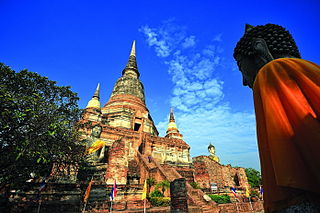
Wat Yai Chai Mongkhon is a Buddhist temple in Ayutthaya, Thailand.

Wat Ratchaburana Ratchaworawihan or usually shortened to Wat Ratchaburana (วัดราชบูรณะ), commonly known as Wat Liap (วัดเลียบ), is a second-class temple in Maha Nikaya sect of Buddhism, located at 119 Chakkraphet Road, Wang Burapha Phirom Subdistrict, Phra Nakhon District, Bangkok at the foot of the Memorial Bridge near Pak Khlong Talat and Praisaniyakarn, diagonally from the Long Corridor of Suankularb Wittayalai School.

Wat Ratchapradit Sathit Mahasimaram Ratcha Wora Maha Viharn is a Buddhist temple in the Phra Nakhon District of Bangkok. Wat Ratchaparadit was designated a first-class royal monastery in 1915, making it one of the most significant temples in Thailand.
The history of Theravāda Buddhism begins in ancient India, where it was one of the early Buddhist schools which arose after the first schism of the Buddhist monastic community. After establishing itself in the Sri Lankan Anuradhapura Kingdom, Theravāda spread throughout mainland Southeast Asia through the efforts of missionary monks and Southeast Asian kings.